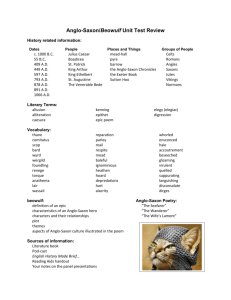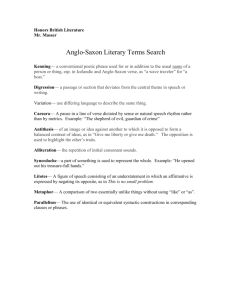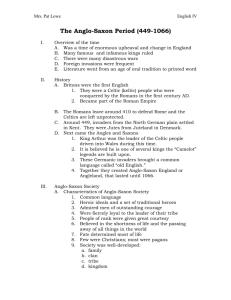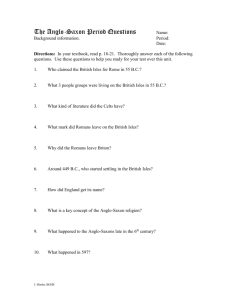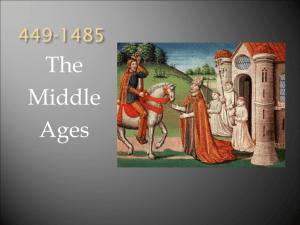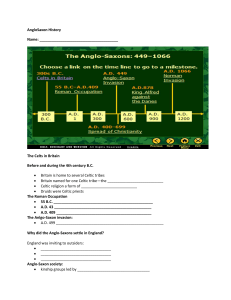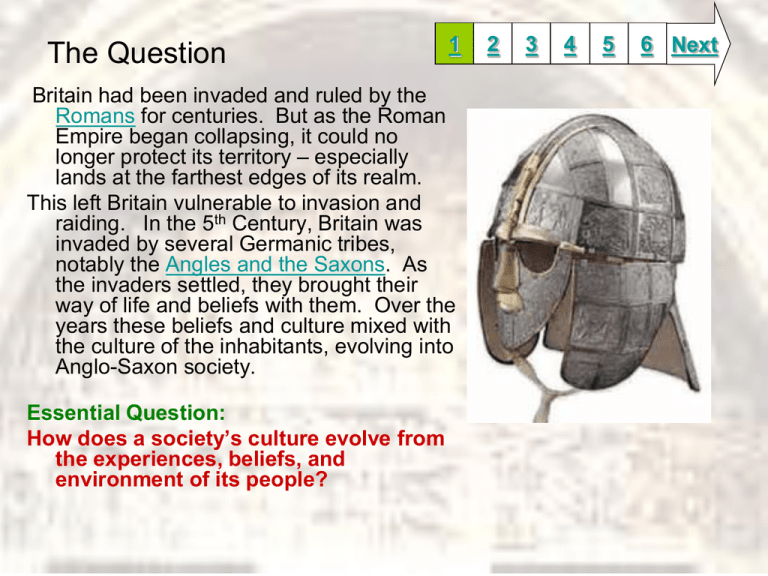
The Question
1
Britain had been invaded and ruled by the
Romans for centuries. But as the Roman
Empire began collapsing, it could no
longer protect its territory – especially
lands at the farthest edges of its realm.
This left Britain vulnerable to invasion and
raiding. In the 5th Century, Britain was
invaded by several Germanic tribes,
notably the Angles and the Saxons. As
the invaders settled, they brought their
way of life and beliefs with them. Over the
years these beliefs and culture mixed with
the culture of the inhabitants, evolving into
Anglo-Saxon society.
Essential Question:
How does a society’s culture evolve from
the experiences, beliefs, and
environment of its people?
2
3
4
5
6 Next
Information Sources
1
2
3
4
5
6 Next
Use the information sources below to gather information about Anglo-Saxon
England and its culture.
–
–
–
–
Ancient History In-Depth -The Anglo Saxons
Anglo-Saxon England
Brief History of Anglo-Saxon England
Exploring England’s Anglo-Saxon Heritage Database article from
Student Resource Center Gold
Here are some questions to start your thinking:
•What elements make up a culture?
•Why is it called culture? (Click to go to Visual Thesaurus.
Type the word culture in the search box. When
the word cloud appears, run your mouse over the dots closest to the word culture for the definitions. )
•Why does culture change over time?
•What influences culture?
Write down 2-3 questions of your own that will help focus your research and
answer the big question:
How does a society’s culture evolve from the experiences, beliefs, and
environment of its people?
The Student Activity
1
2
3
4
5
6 Next
You will research a portion of the Anglo-Saxon culture and create a product which
helps others understand the life and beliefs of the people as background for
Beowulf. Use the websites linked on the previous slide.
Your teacher will assign you to one of six groups: social structure, government,
arts and architecture, religion, education, or daily life. You and the members of
your group will collaborate to create a Glogster online poster or a paper poster
which portrays your findings about the culture of Anglo-Saxon England.
Your poster should include graphics and captions which accurately show how the
people lived, and what made up their culture. You will present your poster
(online or paper) during the next class period.
Posters will be shared with the class during which you will use a Cornell note
sheet to help organize your learning. You will write a reflection which answers
the essential question.
To help you gather your information,
use one of these graphic organizers:
Print a copy for note-taking
•Societal Structure
•Government / Political Structure
•Arts and Architecture
•Religion
•Education
•Daily Life
The Assessment Activity
1
2
3
4
5
6 Next
You will be assessed on the completion of your group
poster as well as a reflection which addresses your
understanding of the essential question after viewing all
of the posters.
Take notes on this Cornell Notes Sheet as posters are
presented.
• Poster Rubric
• Reflection Rubric
Enrichment Activities
1
2
3
4
5
6 Next
These are sites for further research and
enrichment. Visit them before you complete
your reflection to solidify your understanding
of Anglo-Saxon history and culture.
• The Sutton Hoo Society – take an
interactive tour of a group of burial
mounds in England. Explore the
digs and learn about the artifacts
that were unearthed.
• 410-1066 Anglo-Saxon Britain,
Viking Raids, the Norman Invasion –
briefly describes the settlement of
the Anglo-Saxons.
• The Anglo-Saxon Chronicle – a
translation of a chronicle originally
ordered by King Alfred and added to
over the years as a continuing
history. It has been translated from
the Old English.
Teacher Support Materials
Lesson Objective: The student will prepare for reading Beowulf by
researching background information on Anglo-Saxon England.
MSC Standards for English:
•
1.1.1 The student will prepare for reading, viewing, and/or listening
to a text.
- Research background information as a preparation for reading.
•
3.1.5: The student will create effective media presentations that
use visuals and/or sound and appropriate technology to present a
particular point of view on a topic or idea
•
5.1.2 The student will participate in and contribute to large- and
small-group collaboration for a variety of assigned and selfselected purposes
•
5.2.3 The student will use appropriate props, visual aids, and
electronic media to enhance accuracy and audience appeal
•
6.1.2 The student will demonstrate understanding of information
and ideas communicated orally
AASL Standards for the 21st Century Learner:
•
1.1.6 Read, view, and listen for information presented in any
format (e.g., textual, visual, media, digital) in order to make
inferences and gather meaning.
•
2.1.6 Use the writing process, media and visual literacy, and
technology skills to create products that express new
understandings
•
3.1.1 Conclude an inquiry- based research process by sharing new
understandings and reflecting on the learning.
•
3.1.3 Use writing and speaking skills to communicate new
understandings effectively
•
3.1.4 Use technology and other information tools to organize and
display knowledge and understanding in ways that others can
view, use, and assess
1
2
3
4
5
6
ISTE NETS for Students:
•
Students demonstrate creative thinking, construct knowledge, and
develop innovative products and processes using technology.
•
Students use digital media and environments to communicate and
work collaboratively, including at a distance, to support individual
learning and contribute to the learning of others
•
Students demonstrate a sound understanding of technology
concepts, systems, and operations.
Time Management:
•
The lesson should take two days. The first day is for research and
creation of product. Day two is for sharing of the products and
completing the reflection. The reflection could be assigned for
homework.
Differentiation Strategies:
•
Group/partner students heterogeneously by reading ability and
technology skills
•
Have students use assistive tools embedded in the BCPS
databases such as read aloud and dictionary links.
Learning Preferences/Styles:
Field dependent, auditory, visual, active, reflective, global,
sequential, kinesthetic
Notes to the Teacher:
•
If you want to use Glogster, you will need to register and set up a
class. Download this document for directions for setting up
accounts and using Glogster. This will need to be done ahead of
•
time. If the product is a poster, have materials available during
class time.
Consult with your Library Media Specialist for help in implementing
the Slam Dunk.
Created by Barb Falkinburg, Library Media Specialist
BCPS Slam Dunk Model, Copyright 2010 , Baltimore County Public Schools, MD, all rights reserved. The models may be used for educational, non-profit
school use only. All other uses, transmissions, and duplications are prohibited unless permission is granted expressly. This lesson is based on Dr. Jamie
McKenzie’s Slam Dunk Lesson module available at http://fno.org/sept02/slamdunk.html .

